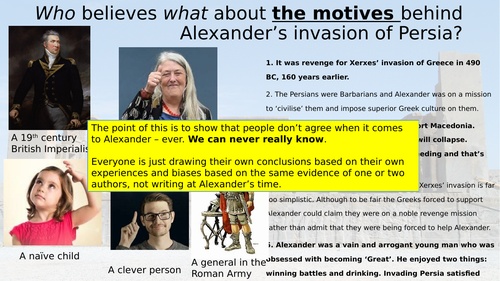

This lesson was designed with the OCR Ancient History 9-1 GCSE spec in mind.
The starter of the lesson offers 5 interpretations of Alexander’s motives for invading Persia, and 5 different characters. Students have to match the interpretation to the character. The point of this exercise is for students to realise there are a wealth of interpretations for Alexander’s motives at every stage of his journey.
The focus then turns to our sources. A passage from Plutarch is presented and students are directed to annotate it while discussing it’s implications.
Similarly, A passage from Arrian is then presented where students do the same.
Both passages, when compared to each other, show different motives for Alexander setting fire to Persepolis, based on their own bias/sources/moral point of view.
A discussion of that these implications then ensues, followed by a directed 20 mark exam question complete with sentence starters.
A model conclusion is then included to allow students to a) see before they begin answering to know what direction in which to take their essay, and b) to use to improve their own answers/conclusions in self-assessment.
The final plenary centres around the fact that Diodorus remains mostly silent on what, to the other authors at least, seems a turning point in Alexander’s Persian campaign.
Something went wrong, please try again later.
This resource hasn't been reviewed yet
To ensure quality for our reviews, only customers who have purchased this resource can review it
Report this resourceto let us know if it violates our terms and conditions.
Our customer service team will review your report and will be in touch.